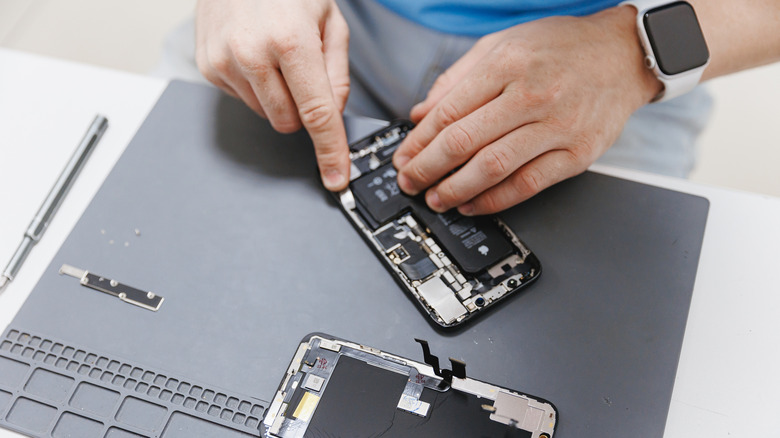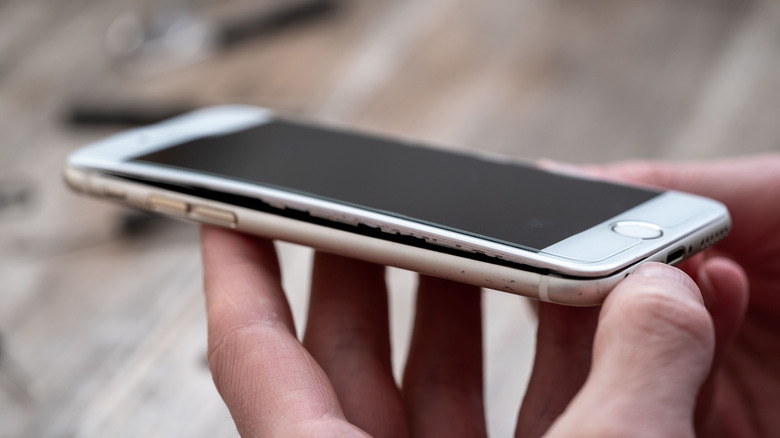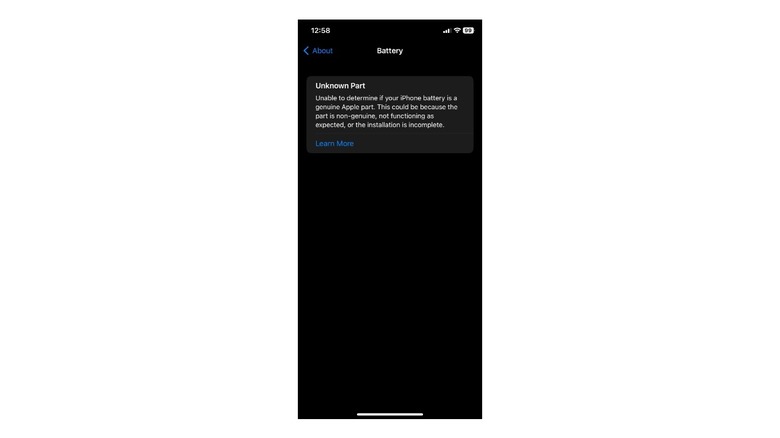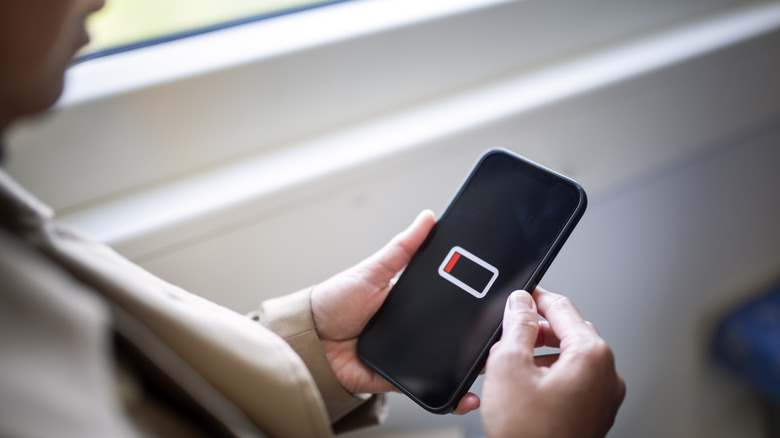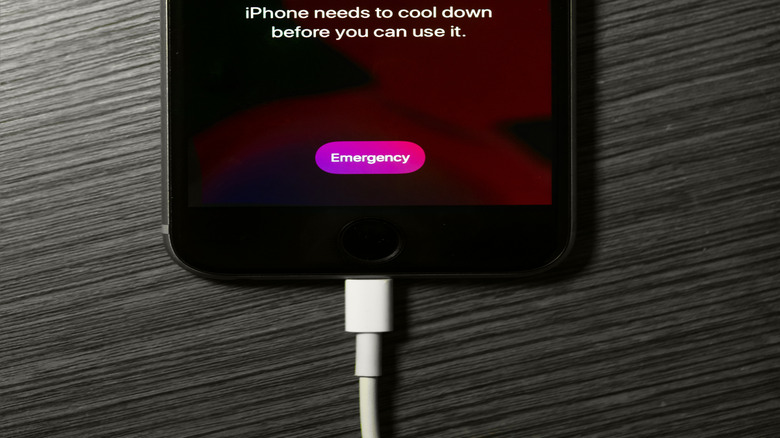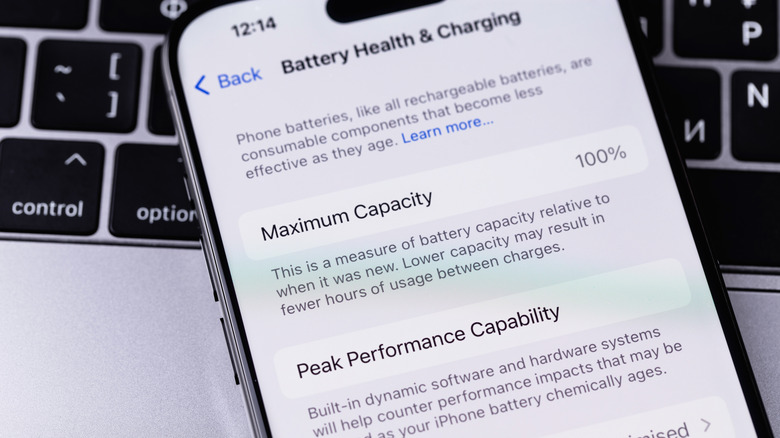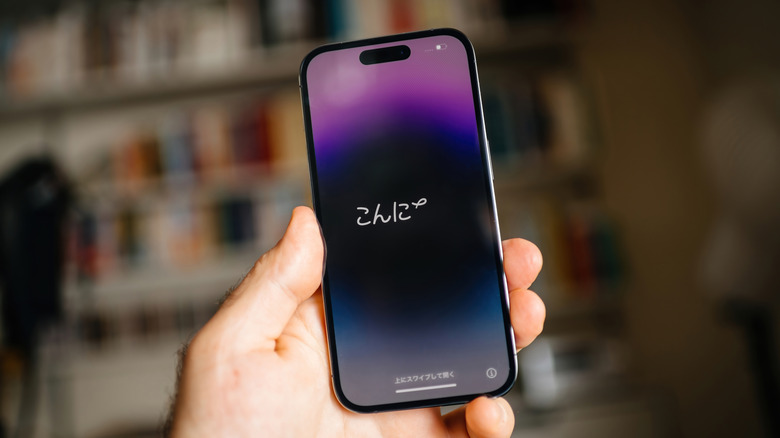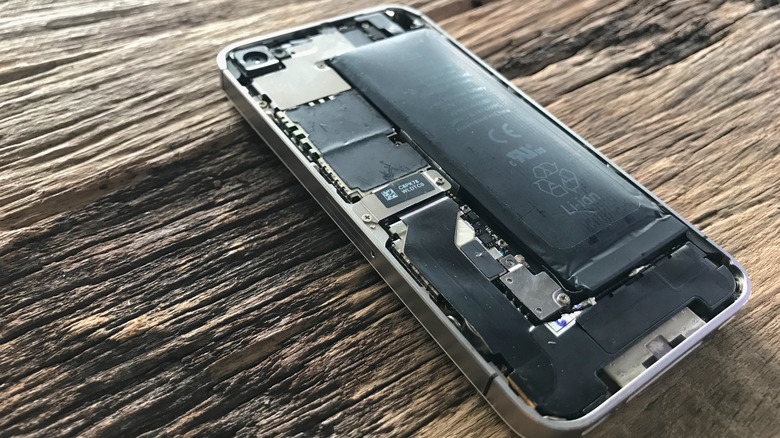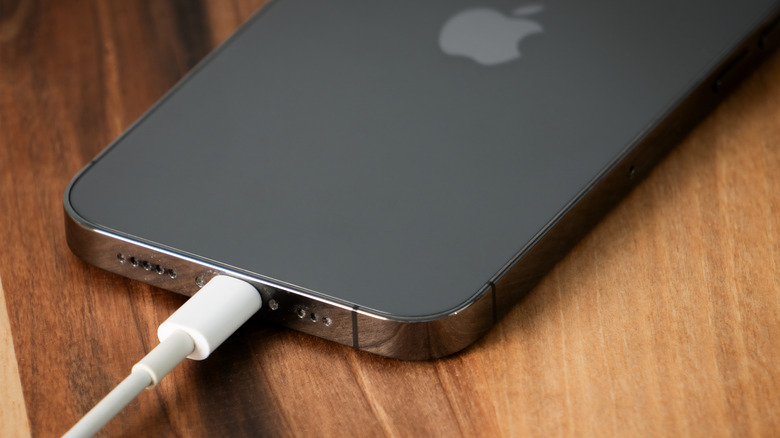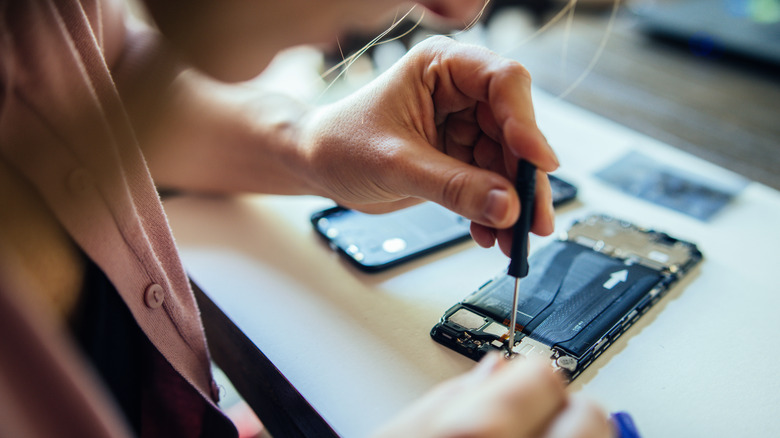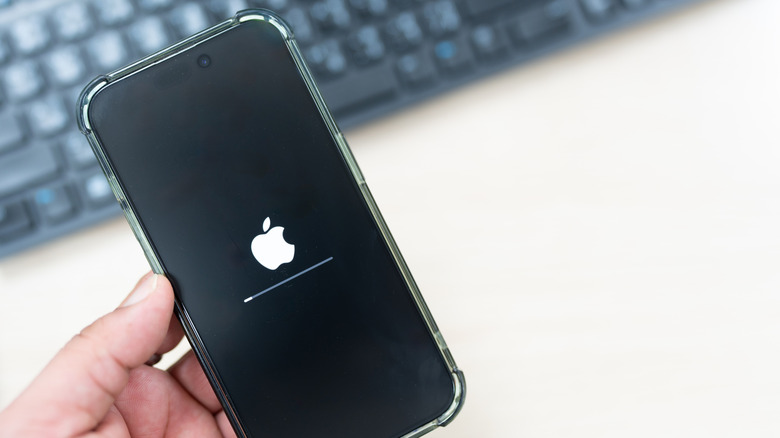10 Reasons You Shouldn't Get A Third-Party Battery For Your iPhone
Most flagship phones nowadays are quite expensive, comfortably breaching the $1,000 mark. As a result, the majority of consumers spending so much money on a phone would want to use it for a long period — perhaps 3 or 4 years at the very least. While modern-day phones have capable hardware that can easily last for several years, there is one component that degrades over time and needs to be replaced: the battery. If you have an iPhone, you can view the battery health in the Settings menu. It starts at 100% and gradually depletes with usage. Once the number drops below 80%, you may have to get the battery replaced, since it would affect the performance and endurance of the phone.
The simplest and best way to go about it would be to take your iPhone to the nearest Apple Store and get the battery replaced at the Genius Bar. However, some users may consider getting an aftermarket battery replacement via a third-party vendor or store. While it may end up being more cost-effective, it can cause several issues and ruin the experience of using your iPhone. From safety hazards like a swollen battery that can potentially catch fire to reduced performance and endurance, the risks and compromises simply aren't worth it. Here are 10 reasons you shouldn't opt for a third-party battery for your iPhone and should, instead, get it replaced straight from Apple or do it yourself.
Safety concerns
Several brands make replacement batteries for iPhones. While some of them may be good or close to the original one, you never know what manufacturing process was followed, or whether its rated capacity is under safe limits. Lithium-ion batteries are complex components that require precise chemistry and construction. Even slight errors can lead to massive catastrophes, like we saw with the Samsung Galaxy Note 7 a few years ago. Some probable safety concerns of using a third-party battery include the battery swelling up to a point where the display or the back of the phone starts separating from the chassis. This can not only ruin other components like the screen but also compromise the water resistance of the phone.
The bigger issue, though, is that a swollen battery is a massive fire hazard. Due to chemical reactions inside a battery, a small puncture to the surface of the battery can ignite a fire. Hence, carrying a phone with an inflated battery is highly dangerous. If the replacement battery isn't put together well, or it's not resistant to higher temperatures, it may swell up and cause damage not only to your iPhone but also your surroundings and, potentially, life. Since an official replacement part from Apple undergoes several quality checks, the chances of the battery swelling up or bursting into flames are extremely slim.
Unknown part errors
Apple is known to serialize and lock the parts of an iPhone to its motherboard. In simple terms, all the individual components of an iPhone, like the cameras, display, or battery, are programmed to work together with the same motherboard. If you replace any of these parts, they need to be reprogrammed by Apple. Otherwise, the iPhone will keep throwing an error that the replacement part is unknown. While the phone may work normally, constant error messages popping up on the screen can certainly ruin the experience of using the phone. This is exactly what would happen if you get a third-party battery for your iPhone. Even if you get a used battery from a different iPhone, it may not work well with your device due to the different serial numbers.
While your iPhone will continue to work, you will see the Unknown Part error while using the phone or every time you open the Settings app. Apart from the annoying pop-ups with the error message, this may also result in your iPhone not reporting the battery level accurately, since it thinks the battery is non-genuine. So your iPhone's battery may die when it's at 20%, because the software isn't reporting the exact value. When you get a replacement directly from Apple or via an authorized service center, they'll reprogram the replacement battery using a special device. If you opt to replace the battery yourself via Apple's self-service repair program, you can carry out the process by yourself.
Reduced battery life
Every iPhone battery has a certain capacity measured in milliampere hours or mAh. This capacity determines how long your iPhone will last on a single charge. Generally, the larger the mAh number, the longer the battery life of the phone. Of course, there are other factors, like software, optimization, and user habits, that influence the battery life. But the battery capacity is the most important factor. If you want to maximize your iPhone's battery, the battery with the maximum rated capacity is the way to go. That's exactly what you would get with an official battery replacement from Apple. However, if you opt for a third-party option, there's no guarantee that the battery is of the same capacity as the original one that shipped with the phone.
Usually, manufacturers mention the rated battery capacity on the battery's label. So, you may argue that you can use that information to match it with the phone's original battery. Unfortunately, though, there's no way to verify if the capacity mentioned on the label is indeed the true capacity of the battery. Several manufacturers get away with mentioning fake capacity numbers, whereas the original capacity of the cell would be much lower. A battery with a lower capacity would mean that your iPhone wouldn't last as long as it did on a single charge. Moreover, the software would find it tricky to display accurate battery levels since it's programmed as per the original battery capacity. The result is an unreliable iPhone.
Overheating issues
Since iOS isn't programmed to handle aftermarket batteries, poor battery life may be accompanied by overheating issues. The software may not be able to determine the right type of battery, leading to power fluctuations. These fluctuations consume more energy, leading to the battery getting hot quickly. Apart from that, subpar aftermarket batteries may have poor chemistry and construction. The battery terminals may not be attached properly, or the different layers used to insulate the battery may not be installed correctly. These manufacturing issues can lead to overheating as well. Moreover, the voltage supplied by the battery may not be calibrated to the exact voltage required to power the phone.
Furthermore, poor battery installation can also cause overheating issues. If the person installing the battery isn't skilled or doesn't have the right equipment, pinching the flex cable or plugging it in incorrectly can also cause the battery's temperature to shoot up. Constant heating issues can render your iPhone uncomfortable to use for long durations. Persistent overheating can be dangerous for the battery, as it can eventually lead to swelling and a potential fire. This is why it's important to ensure that even if you're replacing your iPhone's battery with a first-party replacement part from Apple, it should be installed correctly for optimum results.
Cannot view battery health
An iPhone has a built-in option to check the health of the internal battery. The battery health on iOS is a good indicator of the state of the battery. As with all cells, the iPhone battery's maximum charge-holding capacity depletes with time as the battery ages chemically. This impacts the battery life of the iPhone, as well as its performance in the long run. Having an indicator helps with estimating when it's time to replace the battery. Apple recommends replacing the battery when an iPhone's battery health falls below 80%. If you used this metric to replace your iPhone's battery, note that you won't be able to use it again if you opt for a third-party replacement.
If iOS detects that you're using an aftermarket battery, and it displays the Unknown Part error, you won't be able to view your iPhone's battery health going forward. This isn't ideal, since you wouldn't get an indication of how quickly your battery's capacity depletes with time, and you wouldn't know when to replace it next. When the battery health drops below 80%, not only will your iPhone last for a shorter duration on a charge, but it may also start lagging or stuttering when performing intensive tasks. The best way out is to use first-party batteries, so that you can always keep an eye on the battery health.
Performance issues
iPhones are flagship devices with extremely powerful chipsets. They can play the latest games, capture 4K videos at 120 fps, and edit those videos right on the phone using iMovie. In short, an iPhone is a powerhouse that can carry out most tasks efficiently. However, this is valid when using Apple's official battery. Using a third-party battery could mean that the voltage supplied to run the phone may not be adequate, or may fluctuate, depending on the quality of the cell used. This would result in performance woes. Additionally, an aftermarket battery may result in overheating, as mentioned above. Every time your iPhone heats up and exceeds a certain temperature, it starts to throttle.
In simple terms, iOS limits the iPhone's performance in order to cool the CPU and battery temperatures and preserve battery. This is why you may have observed that your iPhone's display gets dim, the animations get choppy, and the UI doesn't run as smoothly as it does when it's hot to the touch. So, if you want to maintain the peak performance of your iPhone and don't want it to slow down or lag with time, it's recommended to use a first-party battery straight from Apple. As a side note, also ensure you don't subject your iPhone to high temperatures, as it may reduce the lifespan of the battery.
Shorter battery lifespan
Shorter battery life when using a third-party battery isn't just a temporary drawback. There's a long-term effect on the battery as well that you may not notice immediately, but you certainly will in the long run. An aftermarket battery may not be manufactured with high-quality components, which means the battery chemistry would not be up to standard. As a result, the battery's lifespan in the long run wouldn't be as reliable as an original battery. A battery's life is determined by the number of charging and discharging cycles it undergoes. If a first-party battery lasts for 1,000 cycles before losing a substantial amount of charge, a third-party one may only last for 500-600 cycles before dropping to the same level.
There are two downsides to this. For starters, the battery life of your iPhone reduces quickly compared to an official battery. For instance, if your iPhone lasts 12 hours on a single charge right after the replacement, it may last only 10 hours a couple of months down the line. As time progresses, the number will only continue to fall. The second downside is a fallout of the first one. You would end up needing another battery replacement soon, which would nullify the lower cost spent on a third-party battery. So, it's wiser to spend a little more in the first place for a first-party repair directly from Apple.
Slower charging speeds
Apple's latest iPhones have support for fast charging at up to 30W. Thanks to this, you can charge your iPhone up to 50% in just 30 minutes. This fast charging technology is made possible thanks to both hardware and software integrations. The battery is capable of handling 30W of power, while the software intelligently allocates the right voltage and current required to charge the iPhone quickly and safely, based on the battery and temperature levels. There's also a dedicated power supply IC on the iPhone to handle any power-related operations. When using an official battery, all of these technologies work in tandem to provide fast charging speeds while ensuring the battery and the phone remain safe.
However, if the battery is replaced with a third-party unit, it can render all of the safety mechanisms null and void. The power supply IC may not detect the new battery, and the software won't be able to optimize the charging speeds. As a result, there's a good chance your iPhone will only charge at 5W or 10W — which is extremely slow by today's standards. You may also experience some overheating issues when charging, which will further deteriorate the battery's health. Pro tip: Always use a charger and cable from a reputable brand to ensure your iPhone charges at optimum speeds, and the battery remains safe in the long run.
No future support from Apple
If you're getting an aftermarket battery replacement for your iPhone, chances are that you are getting it done from a third-party retail outlet or repair shop. Or, you could be doing it yourself, if you're adventurous enough. Regardless of which option you choose, you should be aware that Apple may refuse to provide support or repair your iPhone in the future if you take it to an Apple Store. This is because a third party would have already opened up the iPhone, which may have resulted in some other damage if not done carefully. Hence, Apple may refuse to take accountability for your iPhone in case you need a repair.
There are several downsides to this. If your iPhone's motherboard or screen stops working and you need a replacement, you won't be able to get an official repair from Apple. You will have to resort to third-party spares for those components as well, which can lead to further complications. Moreover, repairs via third-party channels could mean that the water-resistant seal Apple applies to an iPhone after a repair wouldn't be available, so your iPhone with a third-party battery may not be water-resistant anymore. If you're someone who frequently uses their iPhone near water, or you go swimming with it, it's best to stick to official repairs since the phone can retain the IP68 rating.
Random shutdowns and reboots
The final annoying repercussion of using a third-party iPhone battery is random reboots. Imagine you're doing an important task on your iPhone, only for it to turn off automatically. This can get extremely frustrating if it happens several times a day. The primary cause of an issue like this could be poor manufacturing of the battery, a bad flex cable, or improper installation. All three problems mainly occur with third-party replacement parts. If you get an official battery from Apple, there are quality control checks that are done to ensure the replacement battery is of good quality.
Even if the aftermarket battery is installed properly, issues like overheating can cause the iPhone to throttle and turn off randomly. Since most third-party batteries don't come with any warranty, you won't even be able to get a free replacement in case things go wrong. If the installation hasn't been done properly, it may even lead to other issues like short circuits, which can be dangerous. A lot of these issues with third-party batteries are interlinked. A short circuit may lead to the battery swelling up, which can, in turn, catch fire. Hence, it's best to pay a slightly higher fee upfront to get a first-party battery that will keep your iPhone safe while retaining optimal performance.
